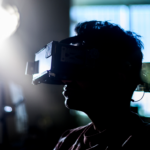About Peter Bex
My research uses cross-disciplinary approaches to study basic and clinical vision science.
Current models of visual perception have been developed to understand behavior under a limited set of idealized laboratory conditions. However, we live in a dynamic and cluttered environment and move our eyes several times each second. My basic visual neuroscience research aims to extend models of sensory processing from laboratory settings to real world conditions. This involves the study of moving natural images that contain multiple objects, three-dimensional structure while observers make eye movements.
My translational clinical research uses behavioral and computational techniques to study the pathological processes in blinding eye diseases including Age-related Macular Disease, Glaucoma and Amblyopia. My research aims to understand the bases and implications of these blinding eye diseases with the goal of developing efficient and sensitive methods for early diagnosis and to measure the presence and progression or remediation of vision loss. Treatment of many eye diseases with conventional ophthalmic techniques is of limited benefit, my lab therefore develops new technologies and novel therapeutic approaches that help to maximize residual visual function and promote the most effective rehabilitation.
The Translational Vision Lab uses cross-disciplinary approaches to study basic and clinical vision science. Their basic visual neuroscience research aims to extend models of sensory processing from laboratory settings to real world conditions.



